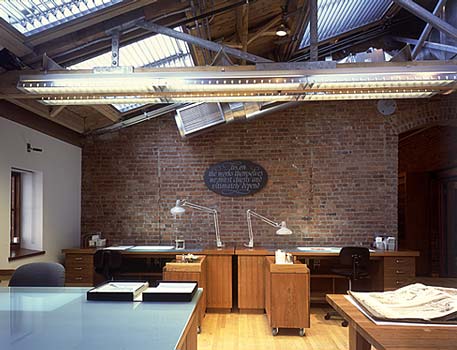This post was created by Lindsey Tyne, Associate Paper Conservator
Several of the drawings included in Édouard Vuillard: Sketches and Studies come from sketchbooks spanning the artist’s entire career with dates as early as the 1890s to the 1930s. This exhibition provides the unique opportunity to learn about Vuillard’s preferred sketching materials. While preparing the drawings for installation, I looked for connections among them, with particular attention to similarities and differences in the physical evidence. A primary question guided my thinking: Are any of the drawings from the same sketchbook?
Let’s consider Attentive Face (Figure 1; 2019.286) and Young Woman Seated on a Sofa (Figure 2; 2019.287) both from ca. 1920.
These drawings are on sheets of machine-made wove paper that are very close in size, color, thickness, and texture. In addition, both have perforations along the left edge where Vuillard folded and tore the sheet to remove it from its sketchbook (Figure 3).
This physical evidence suggests that the drawings could possibly be from the same sketchbook, until we compare the right corners. Attentive Face has square corners (Figure 4), while Young Woman Seated on a Sofa has machine-rounded corners (Figure 5). Vuillard must have used two similar sketchbooks, one with square corners and the other with rounded corners.
Another pair of drawings to consider is Large Trees, ca. 1928 (Figure 6; 2019.291) and Chateau des Clayes, ca. 1930 (Figure 7; 2019.292).
These drawings are on sheets of similar machine-made wove paper of nearly identical size. Each sheet has the same number, size, and spacing of holes along the lower edge indicating their removal from a spiral-bound sketchbook (Figure 8). Both have machine-rounded upper corners (Figure 9). However, Vuillard is thought to have created these drawings two years apart. This leaves us to wonder if he used the same sketchbook over many years, or if he had more than one of the same type of sketchbook in his studio. The physical evidence of this pair alone is inconclusive.
In addition to looking for similarities and differences among the drawings, my work for the exhibition included the treatment of two drawings that were adhered to another sheet of paper, Corner of the Garden, ca. 1920 (Figures 10a and 10b; 2019.288) and The Coffee Pot, ca. 1920 (Figures 11a and 11b; 2019.289). This additional paper was not original to the format of the drawings, so I removed it by softening the adhesive and slowly peeling the paper away (Figure 12).

[Figure 12]
Verso of Corner of the Garden, ca. 1920, during treatment, showing the additional paper partially removed.
The removal of the additional paper allows us to see the edge characteristics and versos of the drawings (Figures 13a and 13b, Figures 14a and 14b) including the perforations along the left edge of Corner of the Garden (Figure 15), indicating it was removed from a sketchbook, and the four irregularly torn edges of The Coffee Pot (Figure 16), with no evidence of it being from a sketchbook. So while these drawings were mounted in the same way at some point in the past, the sheets are different in size, color, and texture, allowing us to conclude that they are not from the same sketchbook.
The current exhibition, and its online counterpart, invite us to compare Vuillard’s drawings and discover similarities among them (Figure 17). However, it is the subtle differences, like those highlighted above, that suggest that none of these drawings are from the same sketchbook, but rather they are from many sketchbooks.
IMAGES
Janny Chiu, 2020, figures 1–9, 13–16; Graham S. Haber, 2021, figure 17; Lindsey Tyne, 2020, figures 10–12





















